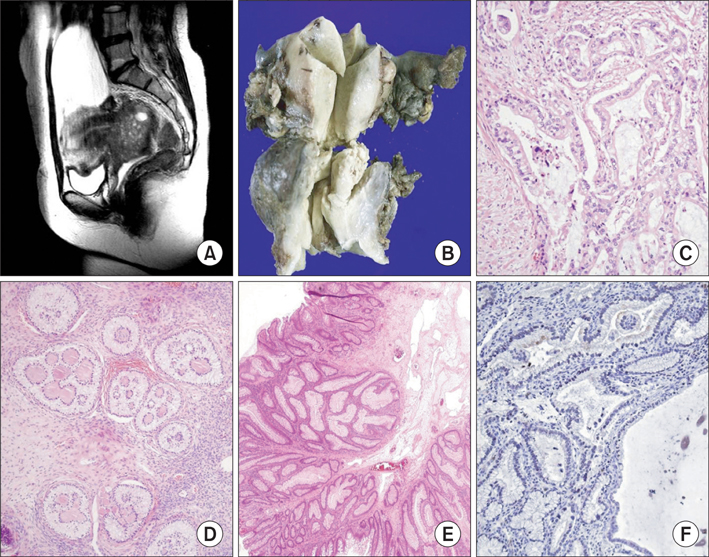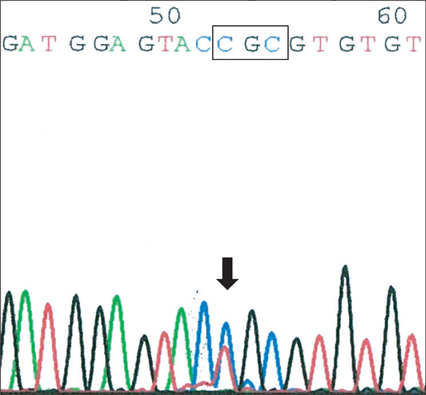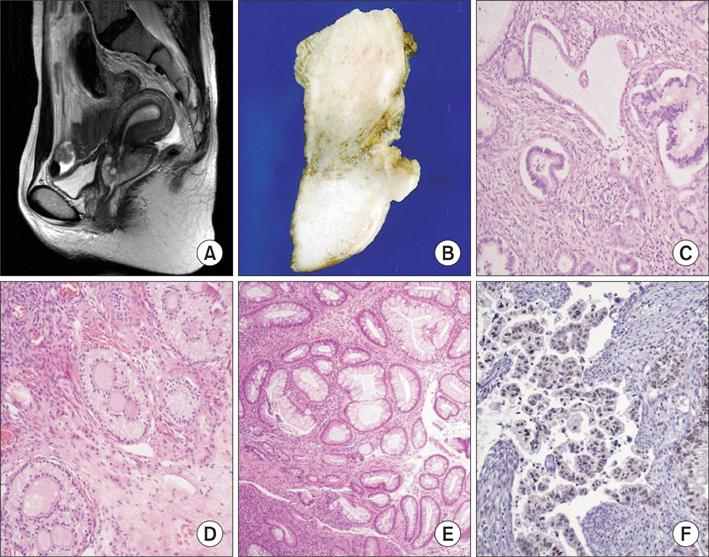J Gynecol Oncol.
2013 Jan;24(1):92-95. 10.3802/jgo.2013.24.1.92.
Minimal deviation adenocarcinoma of the cervix and tumorlets of sex-cord stromal tumor with annular tubules of the ovary in Peutz-Jeghers syndrome
- Affiliations
-
- 1Department of Pathology, Keimyung University School of Medicine, Daegu, Korea.
- 2Department of Radiology, Keimyung University School of Medicine, Daegu, Korea.
- 3Department of Obstetrics and Gynecology, Keimyung University School of Medicine, Daegu, Korea. c0035@dsmc.or.kr
- KMID: 2288565
- DOI: http://doi.org/10.3802/jgo.2013.24.1.92
Abstract
- We report 2 cases of minimal deviation adenocarcinoma of the cervix and tumorlets of sex cord tumor with annular tubules (SCTATs) of the ovaries, accompanied by Peutz-Jeghers syndrome. Case 1 is a 36-year-old woman and case 2 is a 35-year-old woman. Grossly, the cervix of both cases showed markedly barrel shaped enlargement with an infiltrating tumor. Microscopically, well-differentiated atypical glands were infiltrating into the entire thickness of the cervix. The ovarian masses in case 1 were diagnosed as metastatic carcinoma in mucinous cystadenoma with tumorlets of SCTATs of the ovaries. Multiple scattered tumorlets of SCTATs were also found in the ovary of case 2. By direct DNA sequencing analysis, a frame shift mutation of the STK11/LKB1 gene was identified in case 1. Case 1 represented the more aggressive clinical course, and although the patient received additional combined chemo-radiation therapy, she expired 1 year later. In general, mutation of the STK11/LKB1 gene is associated with poor clinical outcome in malignant tumors accompanied by Peutz-Jeghers syndrome.
MeSH Terms
Figure
Reference
-
1. Tomlinson IP, Houlston RS. Peutz-Jeghers syndrome. J Med Genet. 1997. 34:1007–1011.2. Srivatsa PJ, Keeney GL, Podratz KC. Disseminated cervical adenoma malignum and bilateral ovarian sex cord tumors with annular tubules associated with Peutz-Jeghers syndrome. Gynecol Oncol. 1994. 53:256–264.3. Kuragaki C, Enomoto T, Ueno Y, Sun H, Fujita M, Nakashima R, et al. Mutations in the STK11 gene characterize minimal deviation adenocarcinoma of the uterine cervix. Lab Invest. 2003. 83:35–45.4. Koo YJ, Lee JE, Hong SR, Kwon YS. Co-occurrence of an adenoma malignum and an endocervical-type adenocarcinoma of the uterine cervix in a woman with Peutz-Jeghers syndrome. J Gynecol Oncol. 2010. 21:203–206.5. Hemminki A, Markie D, Tomlinson I, Avizienyte E, Roth S, Loukola A, et al. A serine/threonine kinase gene defective in Peutz-Jeghers syndrome. Nature. 1998. 391:184–187.6. Schumacher V, Vogel T, Leube B, Driemel C, Goecke T, Moslein G, et al. STK11 genotyping and cancer risk in Peutz-Jeghers syndrome. J Med Genet. 2005. 42:428–435.7. Esteller M, Avizienyte E, Corn PG, Lothe RA, Baylin SB, Aaltonen LA, et al. Epigenetic inactivation of LKB1 in primary tumors associated with the Peutz-Jeghers syndrome. Oncogene. 2000. 19:164–168.8. Hardie DG. The AMP-activated protein kinase pathway: new players upstream and downstream. J Cell Sci. 2004. 117:5479–5487.9. Green AS, Chapuis N, Lacombe C, Mayeux P, Bouscary D, Tamburini J. LKB1/AMPK/mTOR signaling pathway in hematological malignancies: from metabolism to cancer cell biology. Cell Cycle. 2011. 10:2115–2120.10. Hearle N, Schumacher V, Menko FH, Olschwang S, Boardman LA, Gille JJ, et al. Frequency and spectrum of cancers in the Peutz-Jeghers syndrome. Clin Cancer Res. 2006. 12:3209–3215.
- Full Text Links
- Actions
-
Cited
- CITED
-
- Close
- Share
- Similar articles
-
- Ovarian Sex Cord Tumor with Annular Tubules: A report of 1 case
- A Case of Ovarian Sex Cord Tumor with Annular Tubules Treated by Laparoscopic Surgery in 8 Year Old Girl
- Peutz-Jeghers Syndrome with Multiple Genital Tract Tumors and Breast Cancer: A Case Report with a Review of Literatures
- Sex Cord Tumor with Annular Tubules and Serous Surface Papillary Carcinoma of the Ovary: A case report
- Pleural Effusion Cytology of the Metastatic Sex Cord Tumor With Annular Tubules




